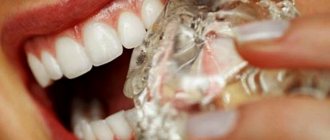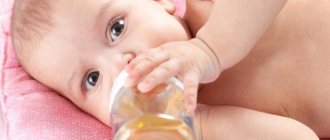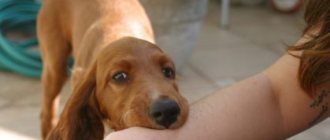At all stages on the way to growing up, a child’s body goes through a lot of crises and undergoes many changes. Experts call the appearance of the first teeth one of the global changes. This is a sign that soon the baby will begin to switch to a different type of food and begin to learn to care for his teeth on his own.
Like any fundamental change, the teething of the first teeth is shrouded in myths and folk “advice,” fears and prejudices. However, not all of them are groundless. Serious changes in a child’s body are noticeable even to inexperienced parents; the teething process can be predicted and greatly facilitated.
Experts identify a number of main symptoms of the appearance of first molars, namely:
- baby's irritability;
- sleep disorders;
- swelling, redness of the gums in the place where the tooth is cut;
- disturbances of appetite, attempts to completely refuse to eat due to the fact that this process causes discomfort to the child;
- increased salivation (and, as a result, a rash on the chin);
- watery eyes;
- the child’s attempts to constantly gnaw or bite something to relieve itching in the gums.
Additional symptoms of teething include:
- slight and short-term increase in body temperature;
- small hematomas in the place where a new tooth plans to appear;
- child's cough (also short-term);
- loose stools (occasional);
- vomiting (clean, due to the fact that the baby swallowed saliva);
- runny nose.
If additional symptoms appear complexly and for a long time, this is a reason to contact a specialist!
Many doctors say that a runny nose when a child’s first baby teeth erupt is absolutely normal. It can manifest itself for several reasons:
- irritation of the nasopharyngeal mucosa;
- allergic reactions;
- mild colds due to decreased body immunity;
- a large volume of saliva that enters the nose.
Despite the fact that teething in general is not a very pleasant process, both for the child and for the parents, the appearance of a runny nose during this period greatly aggravates the situation. The baby does not understand what is happening to him, becomes even more capricious and restless, he needs to pay even more attention, and rinsing and cleansing of the nose is also added to the daily procedures. But the good news is that a runny nose during teething is a normal physiological reaction. In addition, it helps to notice the appearance of a tooth and goes away within 3 days.
How to get rid of a child’s runny nose “on the teeth” - causes of the phenomenon and useful tips
A runny nose during teething in children is quite common. But parents are still worried about whether teething can be accompanied by a runny nose, whether such a symptom will always exist and how many days it lasts, as well as how to distinguish “tooth snot” from a viral infection, allergy or other illness in the child. Below we will answer these and other questions on the topic in detail.
Why does a baby have a runny nose when teething?
What is immunity?
An erupting tooth can significantly reduce immunity. Because of this, pathogenic microorganisms easily penetrate into a fragile body. It is during this period that a child can easily become ill with ARVI or another viral disease.
A baby's first tooth can erupt at about six months. It is during this period that he is transferred to a mixed diet. Complementary foods appear in the baby's diet. He is receiving much less breast milk than before. All these factors can significantly undermine the immune defense of a small organism.
Immunity is the body’s natural defense mechanism against all kinds of dangerous viruses, bacteria, and fungi. Where does it come from in a newborn? It turns out that immune protection is laid down in the mother’s womb. During gestation, the fetus receives antibodies from the mother's body through the placenta. It is these cells that protect the baby from ubiquitous bacteria.
Most antibodies received from the mother are found in the baby’s body immediately after birth. Over time, their number decreases noticeably. This means that the immune defense barrier is weakened. This is why babies often suffer from viral diseases. Their own immunity is not yet able to work at full capacity, and the supply of maternal antibodies is gradually drying up.
When teeth are cut, the gum tissue immediately becomes inflamed.
The task of parents is to strengthen the immunity of their child. To do this, foods rich in vitamins are introduced into his diet. Vitamins A, B, C are especially important. There are many of them in fermented milk products. That is why cottage cheese, cheeses, milk, and kefir must be present in the diet of infants.
What causes a runny nose
Do you get a runny nose during teething? Indeed, it can begin due to the very process of the appearance of new teeth - milk and molars (permanent). After all, the jaw system and the nasal cavity are connected by a huge number of nerve endings and blood vessels. When the gums swell a little, the blood supply to this area increases. Accordingly, more blood will flow to the nasal cavity. The receptors react by releasing more secretion (mucus) - in other words, snot. And it is not at all surprising that when a child teethes, snot appears.
But can there be a runny nose during teething for other reasons? Undoubtedly. Any pediatrician will tell you that just at the moment the first primary incisors appear, i.e. By six months of a baby’s life, “mother’s” antibodies stop protecting the little body. And the immune system, not familiar with the surrounding viruses, reacts to them with snot. That is, a runny nose and illness at this time may not be related to each other (we will later tell you how to distinguish them and what to do). Moreover, eruption as such may not yet occur, because the timing here is arbitrary and deviations of a couple of months are quite normal.
Or they may be connected. For example, the gums became inflamed during teething, so the immunity in the mouth (and nose) was slightly weakened. That is, there is little protection left from microbes, of which there are hundreds of millions in the mouth. Therefore, during teething, rhinitis occurs. Another reason why snot appears is increased salivation due to swollen gums. When lying down for a long time, saliva can penetrate into the nasal cavity and cause a runny nose in the baby.
Interesting to know! Another reason why a runny nose appears during teething in babies is an allergy, most often food. After all, it is at six months that complementary foods begin to be introduced, to which an allergic reaction in the form of snot may occur. Or an allergy occurs when using a new washing powder, dishwashing or bathing detergent, or baby cream.
Allergies may be one of the causes of a runny nose in a child.
Timing of teeth appearance. When do teeth start cutting?
Sometimes parents expect that teeth will start cutting in on time, and if this does not happen, they begin to get seriously nervous, because late appearance of teeth can be one of the symptoms of rickets. And the therapist at the appointment can tell you the timing of their appearance for the same reason.
Don’t panic if your child is already 8-9 months old and still has no teeth. In fact, this is only one of many symptoms of such a serious disease that cannot be considered on its own. The process of teething is individual for each child.
The first tooth can appear between 3 and 10 months. And both extreme options are the norm. Only the later appearance of the first tooth can cause some concern in the absence of other external abnormalities.
The average time for teeth to appear can be represented as follows:
- The 2 lower incisors appear first at 6-8 months of age;
- all 4 upper incisors grow sequentially in the period from 8 to 12 months;
- at approximately 10-13 months, the lower lateral incisors appear;
- the first molars, first the upper and then the lower, are cut at 12-15 months;
- fangs appear at 18-20 months, also first the upper ones, then the lower ones.
All 20 teeth finally appear by 2.5-3 years. Moreover, if the baby’s teeth began to cut early, then the process may be completed earlier - already by 2 years. If, on the contrary, the first tooth appeared only at 9-10 months, the last ones can appear only at 3-5 years.
After a year, the baby may cut several teeth at the same time, and then this process can be really very painful.
Associated symptoms are normal
Having considered the answers to the question whether there can be snot during teething, it is worth dwelling on what symptoms normally accompany a runny nose in children. That is, without the addition of infection. Signs and symptoms are as follows (may be one or a combination of several):
- nasal discharge is clear, thin,
- slight cough (not barking),
- breathing is not difficult,
- loose stools no more than 5 times a day,
- moodiness, loss of appetite,
- increased salivation,
- lacrimation: only if the upper canines are cutting,
- the appearance of redness, bumps on the gums,
- the baby tries to put everything in his mouth, gnaw, bite,
- temperature: as a rule, normal or does not exceed 37.7-38.3 degrees Celsius. But in some children it can occasionally rise to 39 degrees or higher - especially when canines, second primary molars or several molars erupt at the same time,
- headache.
When does snot appear during teething?
How long does the snot last? Normally, a runny nose appears approximately 2-3 days before teething, then quickly stops. The elevated temperature can last 1-3 days, but no more than 5 days.
Brushing our first teeth
Some parents believe that oral hygiene should be started when the baby already has several teeth; until then, there is simply nothing to brush. In fact, there are plaques on the child’s gums. These are small films that can accumulate food debris and be a source of infection. For this reason, dentists recommend starting to brush your teeth before they even appear.
It is not recommended to use a full-fledged toothbrush until the age of two. Oral hygiene can be carried out with a special children's brush, which is placed on your finger, or simply with a small piece of gauze soaked in boiled water.
The child’s mouth needs to be cleaned 1-2 times a day, and after the first teeth appear, special attention should be given to them to prevent the development of caries in the future.
What signs do indicate illness?
To decide on methods of helping your baby, you need to understand what kind of runny nose during teething in infants - physiological (reaction to teeth) or caused by illness. It is important to understand how many days a runny nose lasts, how “thick” it is, etc. Let's consider what symptoms indicate the pathological condition of the child:
- on days 2-3, mucus from the nose acquired a greenish tint,
- The snot is thick, it’s hard to blow your nose, your nose is stuffy,
- runny nose does not get better after 3 days or becomes very severe,
- breathing is difficult, there is wheezing,
- the throat is very red, it hurts, it hurts to swallow,
- a rash, blisters, plaque of different shades appeared in the mouth,
- persistent cough, dry barking cough,
- too pale or red face,
- headache,
- diarrhea (stool more than 5 times a day), vomiting,
- elevated temperature lasts more than 3-5 days,
- high temperature does not rise above 38.5 degrees Celsius,
- the child has very cold hands and/or feet, cramps,
- the baby is constantly drawn to sleep (this may indicate intoxication),
- the gum was very swollen, festered, and a dark clot appeared inside it (perhaps it was a cyst).
Temperature in a child when new teeth appear
It is important to know! If you experience any of these symptoms, you should consult a doctor! Moreover, it is urgent if the child has impaired consciousness, a very high “unbreakable” temperature, a barking cough, a pale or “bluish” nasolabial triangle, vomiting, diarrhea, constant drowsiness during the day, convulsions, severe pain.
Treatment of infectious diseases
If the runny nose is thick, yellow or green, the mucus is difficult to clear and makes breathing significantly more difficult, and there are other alarming symptoms (dry cough, high temperature), then you need to call an ambulance or a local pediatrician. Self-medication in this case is unacceptable.
To eliminate the problem, in addition to rinsing the nose with saline solutions, the doctor may prescribe specialized products for the throat (Lazolvan, Sinekod, Lizobakt) and nose (Protorgol, Pinosol and others), painkillers and antipyretics (Nurofen ", "Panadol"), antiviral ("Viferon"). To recover faster, the child needs bed rest and rest.
Ways to alleviate the condition
What to do and how to treat a runny nose during teething? Here, various methods come to the aid of parents - medications and devices, a certain diet and conditions in the room where the baby is constantly present. Let's take a closer look at them.
“With my older child, we had no problems with teeth. And the youngest one showed it in full – he’s snot streaming, which means he’s teething. In principle, the drops helped, but not for long. So the whole family had to listen to the whims for 2-3 days, and, of course, they didn’t get enough sleep. And then everything passed quickly.”
Polina K., review from baby.ru
Creating an indoor microclimate
How to treat snot during teething? Simple actions by adults can help with this. The room where the baby is located must have appropriate conditions - air temperature within 18-23 degrees Celsius, air humidity within 40-70%. Ventilate the room more often, turn down the heating radiators in the cold season, humidify the air if necessary (using a humidifier). Then the mucus from the nose will not thicken and will separate well.
Regular maintenance of the nursery is necessary









